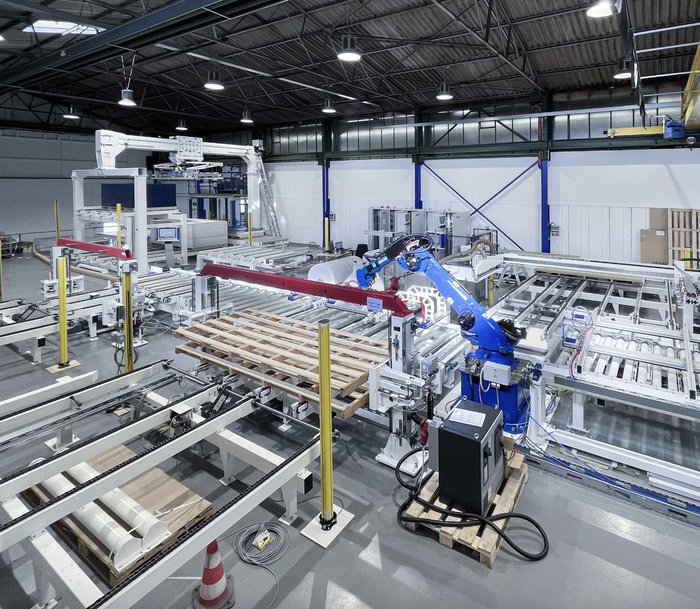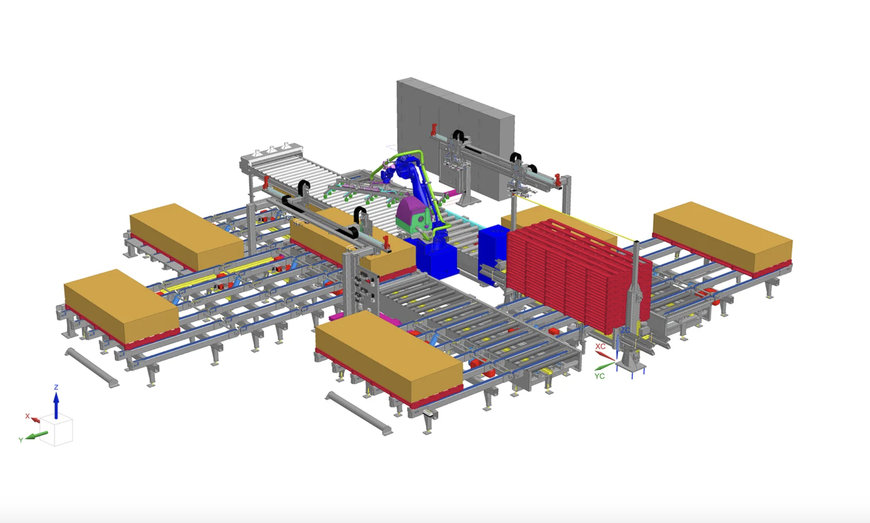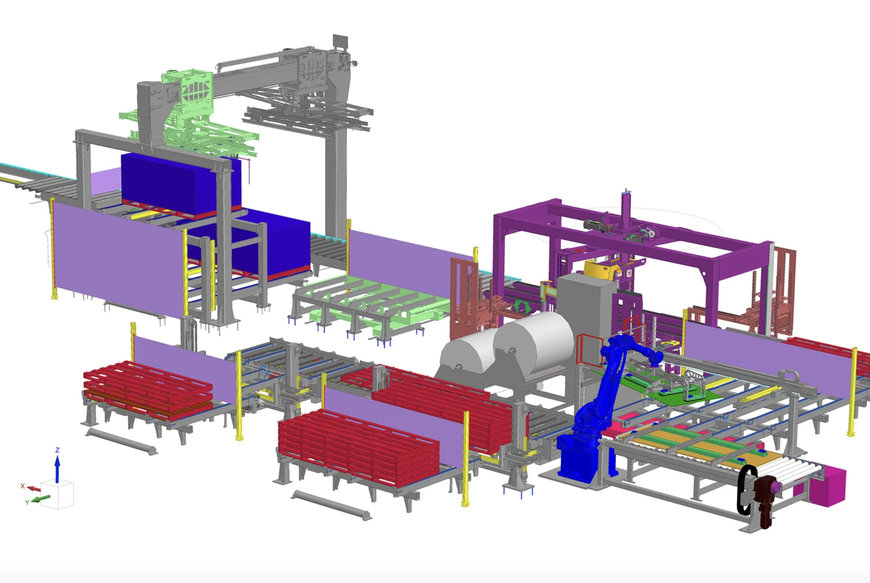www.ptreview.co.uk
12
'24
Written on Modified on
Yaskawa: Digital twin optimises Bürkle systems
With an integrated tool chain, Robert Bürkle GmbH shows how to plan, build, and commission complex systems more efficiently.
www.yaskawa.eu.com

Thanks to the simulation, Bürkle saves not only time during commissioning the real system, but also material and labor costs; it also benefits from significant efficiency gains, higher employee satisfaction, and pretested and verified solutions.
A few clicks, then the robot picks up one of the exterior building panels that exits from the coating system, turns it, and then transports it to the stacking unit. Then an error message pops up, indicating that the holding force has fallen too low. Normally, the panel, which weighs around 80 kg, would then fall to the floor unchecked. Luckily, Marian Michels, software engineer at Robert Bürkle GmbH, is now able to analyze and eliminate such errors using a digital model: he and his colleagues can now rely on a digital twin for development and design. This digital twin, based on the CAD model of the system as a “single source of truth,” serves as the foundation for all subsequent steps of the process, as Jürgen Müller, head of mechanical design at Bürkle, explains.
Responding to new market challenges
What sounds very theoretical at first becomes more practical when you take a closer look at the market environment of Robert Bürkle GmbH: the company is a pioneer in the field of coating technologies for many industries and applications. The spectrum of products ranges from credit cards, printed circuit boards, and photovoltaic modules to furniture and wooden building materials. “This diversity challenges us to implement, maintain, and improve a large number of processes and system concepts,” Müller continues. Most of the systems are individually tailored to specific customer requirements. Bürkle, in turn, must provide and maintain the corresponding know-how for commissioning and service for its users worldwide. For this reason, the design management team piloted the first initiatives for model-based system development and commissioning some time ago. “This allows us to make better use of our resources both in programming and in designing and fine-tuning the systems more efficiently,” says Müller.
The right partners and tools
Then, two opportunities brought virtual commissioning at Bürkle a huge step forward: a large customer project well-suited as a pilot project for virtual commissioning, and the end-to-end tool chain from Siemens. The collaboration with Siemens proved very successful, and Bürkle was able to present its virtual commissioning at LIGNA, the most important trade fair for the wood industry, Müller continues: “The solution for the digital twin that Siemens presented to us was a very good match for our existing tool landscape.” The integrated tool chain—with the NX Mechatronics Concept Designer for mechatronic development, Simit for simulating the automation application, and PLCSim Advanced as a virtual image of the physical Simatic controller that will later be installed—works perfectly with the engineering in TIA Portal. This tool chain eliminates unnecessary system discontinuities, and Bürkle can integrate new tools into its development processes more easily. Ultimately, every developer should be able to carry out virtual commissioning, Müller states: “We don’t want to have one expert but will use the digital twin in our day-to-day work.” The seamless cooperation with Siemens’ software tools also means that Bürkle does not have to enter data multiple times.

Using the digital twin of the line, the developers can create the program efficiently and test all processes in the system quickly and easily, thus eliminating errors at an early stage.
Two projects in parallel
As a software engineer, Marian Michels was responsible for first implementing the digital twin—and had to deal with two projects at once: first, preparing the showcase for the trade fair, and second, commissioning, both virtually and in real life, a complex system used to paint external building panels. “The crux of the customer project was that the panels have very special material properties. That’s why we used a robot with a specially designed holding fixture,” Michels explains. For the trade fair presentation, the virtual commissioning also had to be “polished” as a showcase of the company’s expertise. However, Michels was able to count on Siemens’ support for both projects: “We worked very well together, both during the project and afterwards—we didn’t have to explain much; our colleagues from the Siemens Application Center (APC) knew what was important to us and supported us wonderfully, especially with kinematization.” Shortly before the trade fair, there was even time to enhance the presentation with videos and demos—“that was really fun.”
Testing new technologies on the model
Next was the “acid test” for the digital twin: the virtual commissioning of the customer project. The task here was to integrate the robot into the PLC program, including testing that the functionality and operating range were correct. Using the model, Michels was able to detect problems at an early stage and adapt the program accordingly. He benefited greatly from using the Simatic Robot Integrator (SRI), the new standardized interface (“SRCI,” Standard Robot Command Interface) between the robot and the PLC. Thanks to SRI, the sequence can be programmed in the PLC quickly, easily, and without extensive expertise in robotics. Using an international standard, different robot manufacturers can be integrated without having to change the program.
Siemens and Yaskawa, the manufacturer of the robot used in this project, developed the interface together, making it easy to integrate the robot into both the system simulation and the real system— “the prerequisite for us to be able to implement the solution so quickly with a robot and combine virtual commissioning with robotics,” says Marian Michels confidently.
Nevertheless, the project was under enormous time pressure—and virtual commissioning proved its worth here, too: application engineers at Siemens supported the development team at Bürkle. The results were then verified and tested on the model in advance. This advance testing allowed the team to concentrate on the technologically demanding processes involved in separating and stacking. Jürgen Müller is certain: “The schedule for the project was ambitious. The only way to keep the deadlines was with virtual commissioning.”

Using the digital twin of the line, the developers can create the program efficiently and test all processes in the system quickly and easily, thus eliminating errors at an early stage.
Significant savings in time, resources, and materials
The effect of virtual commissioning has been enormous, especially when it comes to integrating the robot into the stacking process, which includes complex movement sequences and a challenging space situation, not least because testing the system with real materials is more efficient, adds Marian Michels: “The plates are three meters long and over one meter wide. You can imagine the effort involved in reloading the system for a trial.” What’s more, Michels was able to supervise a large part of the commissioning virtually from the office. The possibility of remote supervision saves Bürkle not only travel costs, but also time: “A journey of 500 kilometers for commissioning also means that developers then spend five hours in the car. With the digital twin, many things can be tested in advance, and considerably less effort is required for real commissioning, meaning that working time can be spent more efficiently,” explains Müller. Overall, he estimates that the efficiency gains could amount to up to 30%—a significant benefit, considering the scarcity and expense of the resources required for software development.
Inspired by technology
For Jürgen Müller, there is therefore no question that Bürkle will continue to work with the digital twin. The development team is also enthusiastic about the new possibilities: “Our colleagues are literally on fire.” The same enthusiasm was also evident among many visitors at LIGNA, Müller continues: “The feedback from our long-standing customers in particular was: for the next project, we’ll do it like this.” This overwhelmingly positive feedback shows that new technologies can quickly gain a foothold even in the wood industry: “Our users know and see the challenges that complex systems with long start-up times bring with them. That’s why there will be demand for digital solutions like this.” New opportunities are also opening up for Bürkle now, Müller continues: “We may soon be able to commission the entire plant virtually and then take the fully tested components directly to on-site commissioning.” According to Müller, software development used heavily depend on software engineers’ ability to imagine the finished product: “With the digital twin, things are different now.”
Source and Copyright ©Text: Siemens AG
Source and Copyright ©Pictures: Robert Bürkle GmbH
A few clicks, then the robot picks up one of the exterior building panels that exits from the coating system, turns it, and then transports it to the stacking unit. Then an error message pops up, indicating that the holding force has fallen too low. Normally, the panel, which weighs around 80 kg, would then fall to the floor unchecked. Luckily, Marian Michels, software engineer at Robert Bürkle GmbH, is now able to analyze and eliminate such errors using a digital model: he and his colleagues can now rely on a digital twin for development and design. This digital twin, based on the CAD model of the system as a “single source of truth,” serves as the foundation for all subsequent steps of the process, as Jürgen Müller, head of mechanical design at Bürkle, explains.
Responding to new market challenges
What sounds very theoretical at first becomes more practical when you take a closer look at the market environment of Robert Bürkle GmbH: the company is a pioneer in the field of coating technologies for many industries and applications. The spectrum of products ranges from credit cards, printed circuit boards, and photovoltaic modules to furniture and wooden building materials. “This diversity challenges us to implement, maintain, and improve a large number of processes and system concepts,” Müller continues. Most of the systems are individually tailored to specific customer requirements. Bürkle, in turn, must provide and maintain the corresponding know-how for commissioning and service for its users worldwide. For this reason, the design management team piloted the first initiatives for model-based system development and commissioning some time ago. “This allows us to make better use of our resources both in programming and in designing and fine-tuning the systems more efficiently,” says Müller.
The right partners and tools
Then, two opportunities brought virtual commissioning at Bürkle a huge step forward: a large customer project well-suited as a pilot project for virtual commissioning, and the end-to-end tool chain from Siemens. The collaboration with Siemens proved very successful, and Bürkle was able to present its virtual commissioning at LIGNA, the most important trade fair for the wood industry, Müller continues: “The solution for the digital twin that Siemens presented to us was a very good match for our existing tool landscape.” The integrated tool chain—with the NX Mechatronics Concept Designer for mechatronic development, Simit for simulating the automation application, and PLCSim Advanced as a virtual image of the physical Simatic controller that will later be installed—works perfectly with the engineering in TIA Portal. This tool chain eliminates unnecessary system discontinuities, and Bürkle can integrate new tools into its development processes more easily. Ultimately, every developer should be able to carry out virtual commissioning, Müller states: “We don’t want to have one expert but will use the digital twin in our day-to-day work.” The seamless cooperation with Siemens’ software tools also means that Bürkle does not have to enter data multiple times.

Using the digital twin of the line, the developers can create the program efficiently and test all processes in the system quickly and easily, thus eliminating errors at an early stage.
Two projects in parallel
As a software engineer, Marian Michels was responsible for first implementing the digital twin—and had to deal with two projects at once: first, preparing the showcase for the trade fair, and second, commissioning, both virtually and in real life, a complex system used to paint external building panels. “The crux of the customer project was that the panels have very special material properties. That’s why we used a robot with a specially designed holding fixture,” Michels explains. For the trade fair presentation, the virtual commissioning also had to be “polished” as a showcase of the company’s expertise. However, Michels was able to count on Siemens’ support for both projects: “We worked very well together, both during the project and afterwards—we didn’t have to explain much; our colleagues from the Siemens Application Center (APC) knew what was important to us and supported us wonderfully, especially with kinematization.” Shortly before the trade fair, there was even time to enhance the presentation with videos and demos—“that was really fun.”
Testing new technologies on the model
Next was the “acid test” for the digital twin: the virtual commissioning of the customer project. The task here was to integrate the robot into the PLC program, including testing that the functionality and operating range were correct. Using the model, Michels was able to detect problems at an early stage and adapt the program accordingly. He benefited greatly from using the Simatic Robot Integrator (SRI), the new standardized interface (“SRCI,” Standard Robot Command Interface) between the robot and the PLC. Thanks to SRI, the sequence can be programmed in the PLC quickly, easily, and without extensive expertise in robotics. Using an international standard, different robot manufacturers can be integrated without having to change the program.
Siemens and Yaskawa, the manufacturer of the robot used in this project, developed the interface together, making it easy to integrate the robot into both the system simulation and the real system— “the prerequisite for us to be able to implement the solution so quickly with a robot and combine virtual commissioning with robotics,” says Marian Michels confidently.
Nevertheless, the project was under enormous time pressure—and virtual commissioning proved its worth here, too: application engineers at Siemens supported the development team at Bürkle. The results were then verified and tested on the model in advance. This advance testing allowed the team to concentrate on the technologically demanding processes involved in separating and stacking. Jürgen Müller is certain: “The schedule for the project was ambitious. The only way to keep the deadlines was with virtual commissioning.”

Using the digital twin of the line, the developers can create the program efficiently and test all processes in the system quickly and easily, thus eliminating errors at an early stage.
Significant savings in time, resources, and materials
The effect of virtual commissioning has been enormous, especially when it comes to integrating the robot into the stacking process, which includes complex movement sequences and a challenging space situation, not least because testing the system with real materials is more efficient, adds Marian Michels: “The plates are three meters long and over one meter wide. You can imagine the effort involved in reloading the system for a trial.” What’s more, Michels was able to supervise a large part of the commissioning virtually from the office. The possibility of remote supervision saves Bürkle not only travel costs, but also time: “A journey of 500 kilometers for commissioning also means that developers then spend five hours in the car. With the digital twin, many things can be tested in advance, and considerably less effort is required for real commissioning, meaning that working time can be spent more efficiently,” explains Müller. Overall, he estimates that the efficiency gains could amount to up to 30%—a significant benefit, considering the scarcity and expense of the resources required for software development.
Inspired by technology
For Jürgen Müller, there is therefore no question that Bürkle will continue to work with the digital twin. The development team is also enthusiastic about the new possibilities: “Our colleagues are literally on fire.” The same enthusiasm was also evident among many visitors at LIGNA, Müller continues: “The feedback from our long-standing customers in particular was: for the next project, we’ll do it like this.” This overwhelmingly positive feedback shows that new technologies can quickly gain a foothold even in the wood industry: “Our users know and see the challenges that complex systems with long start-up times bring with them. That’s why there will be demand for digital solutions like this.” New opportunities are also opening up for Bürkle now, Müller continues: “We may soon be able to commission the entire plant virtually and then take the fully tested components directly to on-site commissioning.” According to Müller, software development used heavily depend on software engineers’ ability to imagine the finished product: “With the digital twin, things are different now.”
Source and Copyright ©Text: Siemens AG
Source and Copyright ©Pictures: Robert Bürkle GmbH
www.yaskawa.eu.com

